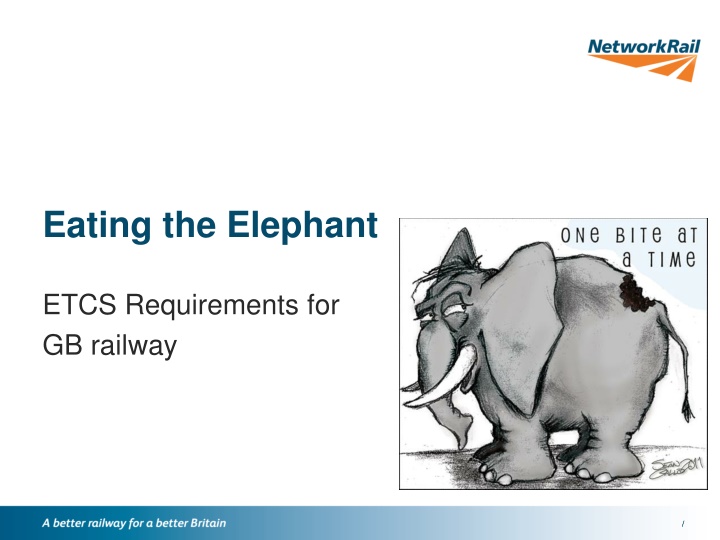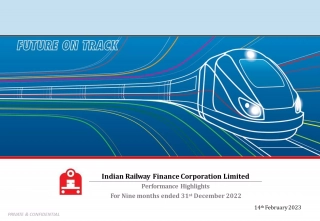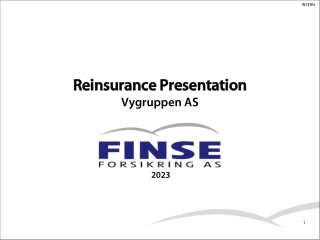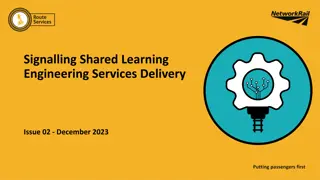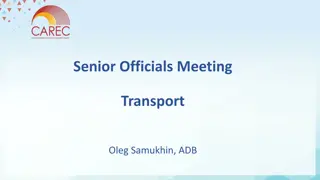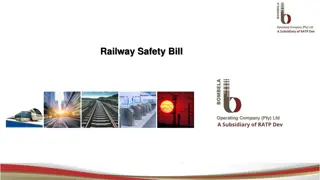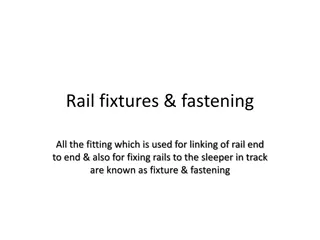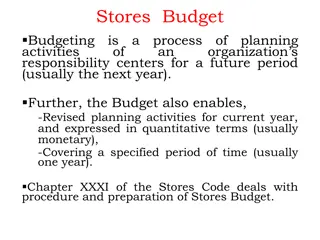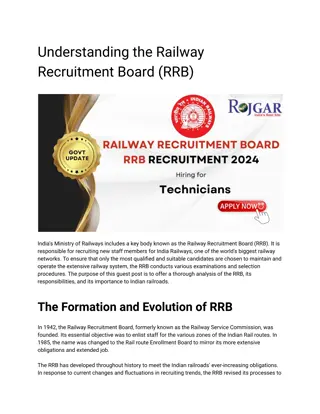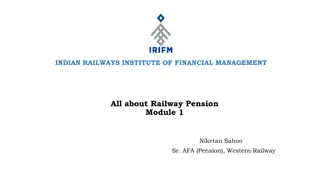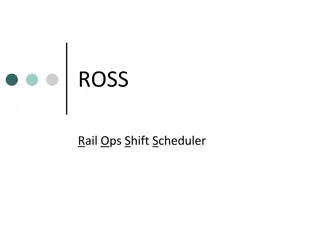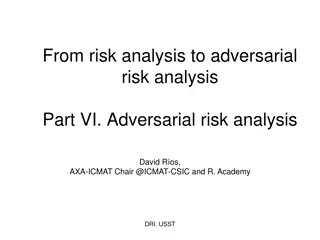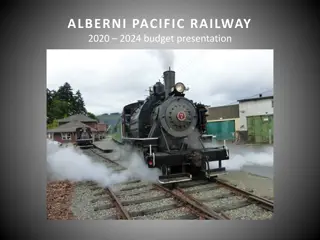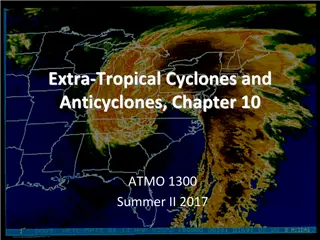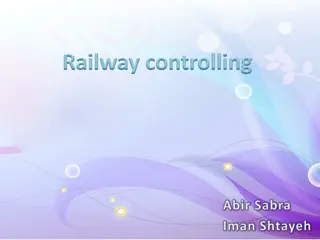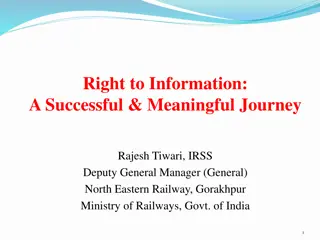ETCS Requirements for GB Railway
This content delves into the ETCS requirements for the GB railway system, covering topics such as the INCOSE Reference Design Process, adoption by the UK government, standard solutions, ERTMS Level 2 functionalities, and challenges in specifying a national application.
Download Presentation

Please find below an Image/Link to download the presentation.
The content on the website is provided AS IS for your information and personal use only. It may not be sold, licensed, or shared on other websites without obtaining consent from the author.If you encounter any issues during the download, it is possible that the publisher has removed the file from their server.
You are allowed to download the files provided on this website for personal or commercial use, subject to the condition that they are used lawfully. All files are the property of their respective owners.
The content on the website is provided AS IS for your information and personal use only. It may not be sold, licensed, or shared on other websites without obtaining consent from the author.
E N D
Presentation Transcript
Eating the Elephant http://assimilationsystems.com/wp-content/uploads/2015/07/one_bite1.jpg ETCS Requirements for GB railway / /
INCOSE - Reference Design process ETCS what is it and how was it developed? A supplier driven product Adopted by the European Union to enable cross-border train travel Incorporated into EU legislation Continuing to develop as each new application identifies opportunities or challenges / 2
INCOSE - Reference Design process Adoption by UK Government Seen as an opportunity to increase capacity Standardised products should allow reduction in costs and increases supply base Addresses previous commitments for the provision of ATP Enables European freight corridors Interpretation of railway interoperability regulations Potential future enhancement to ATO / 3
INCOSE - Reference Design process ETCS a standard solution? Designed to enable fitted trains to travel anywhere in Europe ETCS train functionality is tightly defined Communication protocols between train and track are defined Application to individual trains is not defined http://images.knifecenter.com/knifecenter/sak/images/53861.jpg The trackside application is undefined / 4
ERTMS Level 2 Local control workstation Signalling Control Centre Infrastructure Trains Controls and indications Route & Track Occupancy information GSM-R BTS GSM-R Mobile switching centre And base station controller Radio Block centre Interlocking Movement authorities Train detection Ground frames Worked points Position & status reports Data Radio Voice radio JRU Optional DMI EVC Odometry Doppler Radar Balise Reader Tachometer Balise Balise AWS TPWS INCOSE - Reference Design process / 5
INCOSE - Reference Design process Our challenge To specify a national application for consistency across the Routes To establish the needs and wishes of the Stakeholders To choose solutions that meet safety targets To generate a set of high quality sub-system requirements / 6
INCOSE - Reference Design process Who are the stakeholders? The Railway Undertakings both freight and passenger The Rolling Stock owners The Infrastructure Managers The Safety Regulator The Government http://www.roybeggs.co.uk/wp-content/uploads/2013/12/Scales-of-justice1.jpg Each has its own priorities and aspirations / 7
INCOSE - Reference Design process The European Specification Levels of operation Modes of operation Many different ways of cracking the nut Significant variance in supplier interpretation Suppliers trackside products only implement functionality that has previously been requested The dreaded Euro-English! / 8
INCOSE - Reference Design process The Reference Design Approach To establish common scenarios and the possible approaches to address them Prioritise on safety and performance whilst keeping cost down Identify a set of Patterns which will deliver the Operational Concept To confirm achievability of the Patterns against the European specifications / 9
INCOSE - Reference Design process Building Blocks TSIs, SRS, etc. Reference Design Applications Select and apply Select and assemble / 10
INCOSE - Reference Design process Bringing people to the table Different commercial and political agendas Lack of understanding of ETCS and misunderstanding of ETCS Public statements/private views Establishing real needs versus desires Getting the full representation http://www.snowfish.net/wp-content/uploads/2015/12/Figures-around-the-table.png / 11
INCOSE - Reference Design process What was the problem to be solved? Understanding the objectives Documenting short scenarios Assessing technical solutions Considering the operational approach Refining the solutions Delivering the requirements / 12
INCOSE - Reference Design process Verifying the solutions Safety risk analysis Cross-industry operational workshops Supplier engagement and cross-industry review Pan-european collaboration / 13
INCOSE - Reference Design process Developing the requirements Common scenarios assigned to topics Topics broken down into options and variants Desired behaviour of the system described Analysis of descriptions to elicit requirements http://coopsoft.com/images/dac.jpg / 14
INCOSE - Reference Design process Day in the life of a train Train starts in depot (start of mission process), Train enters ETCS area (N1) in Level 1, Train transitions to Level 2 (N1), Movement authority is extended (A1) several times, Train approaches occupied terminal platform (H1) and transitions to OS mode, Driver brings train to a stand and closes cab (C), Coupling takes place in SB (I), Driver enters cab and undertakes start of mission, Train obtains first movement authority (G2 or G3 followed by A2), Train Dispatch takes place (D), Movement authority is extended (A1) several times, Train approaches critical routing point and routing information is provided (A3), Train is stopped on approach to junction (E), Movement authority is extended (A1), Etc. / 15
INCOSE - Reference Design process Sounds simple but .. Some of the requirements already defined at the European level System definition and boundaries unclear https://pastorjackliberal.files.wordpress.com/2015/05/hurdles.png Establishing the operational context for CSM Managing conflicts and duplicates Getting industry buy-in / 16
INCOSE - Reference Design process The changing standards and environment Baseline 2 to baseline 3 Maintenance release 1 to Release 2 Changes through change control Business/commercial constraints Industry priorities / 17
INCOSE - Reference Design process Managing expectations Misunderstandings of improvements ETCS can provide Promised safety enhancements which may not be deliverable Integration with existing safety processes http://7629-presscdn-0-90.pagely.netdna-cdn.com/wp-content/uploads/2014/02/Managing-Stakeholder-Expectations-1.jpg Bathtub curve / 18
INCOSE - Reference Design process The size of the problem Number of topic areas Number of authors Number of stakeholders Number of workshops Timescales Review cycles Availability of people / 19
INCOSE - Reference Design process The good, the bad and the ugly Enthusiasm and collaboration of the wider team Continual improvement in process and knowledge - innovation The maturity of the European specification The railway culture of those leading the European specifications The difficulty of getting policy decisions who makes them? / 20
INCOSE - Reference Design process Next Steps First tranche of deliverables to Digital Railway completed Operational test scenarios to be developed Ongoing change control Management of changes to Release 2 Development of project application rules https://media.licdn.com/mpr/mpr/AAEAAQAAAAAAAAPgAAAAJGUxN2UyNGMwLTYzYjItNGNmMC1hYTMzLWEzMmYzYjc1MDI0Zg.jpg Simulation and modelling / 21
INCOSE - Reference Design process http://assimilationsystems.com/wp-content/uploads/2015/07/one_bite1.jpg Questions / 22
